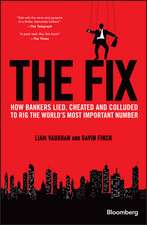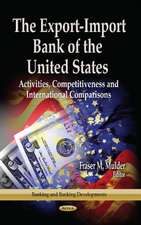International Financial Contagion
Editat de Stijn Claessens, Kirsten Forbesen Limba Engleză Hardback – 30 mai 2001
| Toate formatele și edițiile | Preț | Express |
|---|---|---|
| Paperback (1) | 947.80 lei 6-8 săpt. | |
| Springer Us – 16 sep 2011 | 947.80 lei 6-8 săpt. | |
| Hardback (1) | 958.38 lei 6-8 săpt. | |
| Springer Us – 30 mai 2001 | 958.38 lei 6-8 săpt. |
Preț: 958.38 lei
Preț vechi: 1168.76 lei
-18% Nou
Puncte Express: 1438
Preț estimativ în valută:
183.38€ • 191.47$ • 151.77£
183.38€ • 191.47$ • 151.77£
Carte tipărită la comandă
Livrare economică 04-18 aprilie
Preluare comenzi: 021 569.72.76
Specificații
ISBN-13: 9780792372851
ISBN-10: 0792372859
Pagini: 466
Ilustrații: XII, 466 p.
Dimensiuni: 155 x 235 x 33 mm
Greutate: 0.82 kg
Ediția:2001
Editura: Springer Us
Colecția Springer
Locul publicării:New York, NY, United States
ISBN-10: 0792372859
Pagini: 466
Ilustrații: XII, 466 p.
Dimensiuni: 155 x 235 x 33 mm
Greutate: 0.82 kg
Ediția:2001
Editura: Springer Us
Colecția Springer
Locul publicării:New York, NY, United States
Public țintă
ResearchDescriere
No sooner had the Asian crisis broken out in 1997 than the witch-hunt started. With great indignation every Asian economy pointed fingers. They were innocent bystanders. The fundamental reason for the crisis was this or that - most prominently contagion - but also the decline in exports of the new commodities (high-tech goods), the steep rise of the dollar, speculators, etc. The prominent question, of course, is whether contagion could really have been the key factor and, if so, what are the channels and mechanisms through which it operated in such a powerful manner. The question is obvious because until 1997, Asia's economies were generally believed to be immensely successful, stable and well managed. This question is of great importance not only in understanding just what happened, but also in shaping policies. In a world of pure contagion, i.e. when innocent bystanders are caught up and trampled by events not of their making and when consequences go far beyond ordinary international shocks, countries will need to look for better protective policies in the future. In such a world, the international financial system will need to change in order to offer better preventive and reactive policy measures to help avoid, or at least contain, financial crises.
Cuprins
Preface. Acknowledgments. Contributors. Part I: Overview: The Theory and Empirics of Contagion. 1. International Financial Contagion: An Overview of the Issues and the Book; S. Claessens, K. Forbes. 2. Contagion: Why Crises Spread and How This Can Be Stopped; S. Claessens, et al. 3. Measuring Contagion: Conceptual and Empirical Issues; K. Forbes, R. Rigobon. 4. The Channels for Financial Contagion; M. Pritsker. Part II: Specific Mechanisms Driving Contagion. 5. Crisis Transmission: Evidence from the Debt, Tequila and Asian Flu Crises; J. de Gregorio, R. Valdés. 6. Flight to Quality: Investor Risk Tolerance and the Spread of Emerging Market Crises; B. Eichengreen, et al. 7. Mutual Fund Investment in Emerging Markets: An Overview; G. Kaminsky, et al. 8. Portfolio Diversification, Leverage, and Financial Contagion; G. Schinasi, T. Smith. Part III: Case Studies of Contagion. 9. Thai Meltdown and Transmission of Recession within the ASEAN4 and NIE4; T. Abeysinghe. 10. Financial Contagion in the East Asian Crisis: With Special Reference to the Republic of Korea; Y.C. Park, C.-Y. Song. 11. The Russian Default and the Contagion to Brazil; T. Baig, I. Goldfajn. 12. Contagion of International Financial Crises: The Case of Mexico; S. Bazdresch, A. Werner. 13. Financial Market Spillovers: How Different are the Transition Economies? G. Gelos, R. Sahay. 14. Are Financial Crises Becoming More Contagious?: What is the Historical Evidence on Contagion? M. Bordo, A. Murshid. Part IV:Implications for Policy and the International Financial Architecture. 15. International Contagion: Implications for Policy; R. Chang, G. Majnoni. 16. International Financial Reform: Regulatory and Other Issues; J. Hawkins, P. Turner. Part V: Original Conference Program.
Recenzii
`It is difficult to avoid being impressed by the very high level of quality in this research collection. For those who attended the conference meetings, this comes as no surprise since the atmosphere was wonderfully dynamic and full of tough give and take. That flavor is not lost in this more formal rendition. Before this conference, very little was available in this area. Policy makers, policy research departments and students of emerging-market finance will find a wealth of information in this book. They will also find some answers, plenty of controversy, and lots of open questions.'
Rudiger Dornbusch, Massachusetts Institute of Technology
Rudiger Dornbusch, Massachusetts Institute of Technology












